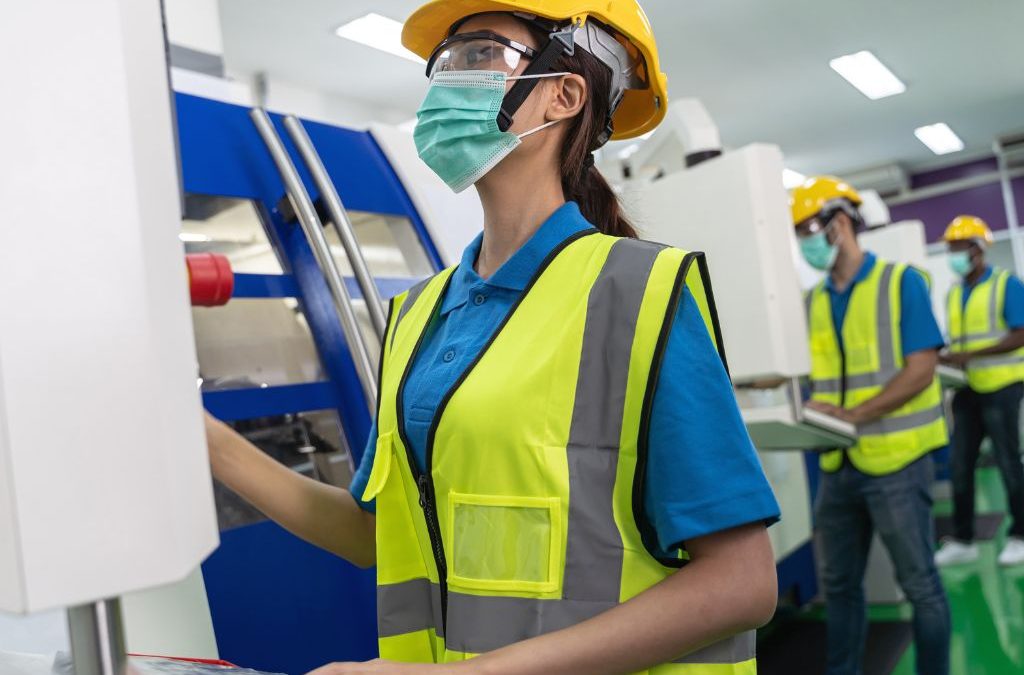Kişisel Koruyucu Donanım (KKD) malzeme bilimi, tasarım ve teknolojideki gelişmelerin etkisiyle son yıllarda önemli ölçüde evrim geçirdi. Endüstriler genelinde daha güvenli işyerlerine yönelik talepler arttıkça, KKD teknolojisi de işçilere daha iyi koruma, daha fazla konfor ve gelişmiş performans sunmayı hedefleyerek gelişmeye devam ediyor. Bu yazıda, KKD'deki en son yenilikleri ve işçi güvenliği için geleceğin neler getireceğini inceleyeceğiz.
KKD'nin Evrimi
KKD onlarca yıldır işçi güvenliğinin temel taşı olmuştur. Başlangıçta, baretler, eldivenler ve solunum cihazları gibi ekipmanlar ilkeldi ve genellikle konfor veya kullanılabilirliğe fazla dikkat etmeden temel koruma sağlıyordu. Ancak, endüstriler daha gelişmiş hale geldikçe, KKD de gelişmiştir. Günümüzün ekipmanları, kimyasallardan ve havadaki patojenlerden yüksek etkili ve aşırı sıcaklık ortamlarına kadar artan bir tehlike yelpazesine karşı koruma sağlamak için tasarlanmıştır. Akıllı teknolojinin KKD'ye entegrasyonu, işyeri güvenlik koşullarının gerçek zamanlı izlenmesini ve çalışanlar için daha iyi korumayı sağlayan önemli bir ilerlemedir.
KKD Teknolojisindeki Yenilikler
- Akıllı KKD: Gerçek Zamanlı İzleme ve Uyarılar: KKD teknolojisindeki en heyecan verici gelişmelerden biri, akıllı sensörlerin güvenlik ekipmanlarına entegre edilmesidir. Bu sensörler, gazlar, aşırı sıcaklıklar ve hatta kullanıcının fiziksel durumu dahil olmak üzere çok çeşitli çevresel tehlikeleri tespit edebilir. Örneğin, sensörlerle donatılmış akıllı kasklar, çalışanları tehlikeli bir alana girdiklerinde veya hayati belirtileri (kalp atış hızı veya vücut sıcaklığı gibi) güvenli aralıkların dışına çıktığında uyarabilir. Bu gerçek zamanlı izleme, yalnızca bireysel çalışanın güvenliğini iyileştirmekle kalmaz, aynı zamanda işverenlere işyeri güvenlik protokollerini optimize etmek için değerli veriler sağlar.
- Geliştirilmiş Solunum Cihazları ve Yüz Maskeleri: Solunum cihazları ve yüz maskeleri COVID-19 salgını nedeniyle ilgi odağı haline geldi, ancak bu alandaki gelişmeler yıllardır devam ediyor. Modern solunum cihazları yalnızca uzun süreler boyunca takmak için daha rahat olmakla kalmıyor, aynı zamanda zararlı parçacıkları filtrelemede de önemli ölçüde daha verimli. Bazı solunum cihazları artık zararlı gazları nötralize edebilen dahili filtrelere sahipken, diğerleri nefes almayı kolaylaştıran küçük pille çalışan fanlarla çalışıyor. Gelecekteki tasarımlar, hem koruma hem de gelişmiş performans sunan tehlikeli ortamlarda görünürlüğü iyileştirmek için artırılmış gerçeklik (AR) lensleri gibi özellikleri bile içerebilir.
- Fiziksel Koruma Amaçlı Dış İskeletler: KKD'deki bir diğer çığır açıcı gelişme giyilebilir dış iskeletlerin geliştirilmesidir. Bu giysiler, hareketlerini destekleyerek, yorgunluğu azaltarak ve yaralanmaları önleyerek işçilerin fiziksel zorlanmasını azaltmaya yardımcı olur. Esas olarak inşaat ve lojistik gibi fiziksel olarak zorlu alanlarda çalışanlar için tasarlanan dış iskeletler, ağır yükleri kaldırmaya yardımcı olabilir ve ek sırt ve eklem desteği sağlayabilir. Bu yenilikler, imalat ve depolama gibi tekrarlayan hareket yaralanmalarının yaygın olduğu endüstriler için özellikle umut vericidir.
- Hafif ve Çoklu Tehlike Koruyucu Giysiler: Yeni malzemeler koruyucu giysilerde de ilerlemelere yol açtı. Geleneksel güvenlik giysileri genellikle hacimli ve rahatsızdı, ancak yeni lifler ve kumaşlar çok daha hafif, daha esnek ve nefes alabilir. Bu, çalışanların güvenlikten ödün vermeden daha özgürce hareket etmelerini sağlar. Bu kumaşlar, konforun yanı sıra kimyasallar, ısı ve elektrik tehlikeleri gibi çeşitli risklere karşı koruma sağlayarak çoklu tehlike koruması sunar. Gelecekteki yenilikler arasında, küçük yırtıkları ve sıyrıkları otomatik olarak onaran, koruyucu giysilerin kullanım ömrünü uzatan ve maliyetleri düşüren kendi kendini onaran kumaşlar yer alabilir.
- Tehlike Tanımlamasında Artırılmış Gerçeklik (AR): AR teknolojisi, tehlike tanımlama ve eğitim için KKD'de giderek daha fazla kullanılıyor. Akıllı gözlükler ve kasklar artık kullanıcının gerçek dünya görüşüne dijital bilgiler yerleştirerek olası tehlikeleri, güvenlik protokollerini ve acil durum prosedürlerini vurgulayabilir. İnşaat sahaları veya kimyasal tesisler gibi karmaşık ortamlarda, bu teknoloji çalışanlara kılavuzlara veya diğer harici kaynaklara başvurmaya gerek kalmadan önemli bilgilere anında, gerçek zamanlı erişim sağlar.
İşçi Güvenliğine Yönelik Sonuçlar
Bu gelişmelerin etkisi işçi güvenliği önemlidir. İşverenler, KKD'ye son teknolojiyi dahil ederek, işyeri risklerini azaltmak ve çalışanları için daha güvenli ortamlar yaratmak için daha iyi donanımlı hale gelir. Akıllı KKD, acil durumlarda daha hızlı yanıt süreleri, iyileştirilmiş tehlike tespiti ve gelişmiş iletişim sağlar. Ayrıca, dış iskeletlerin ve hafif malzemelerin entegrasyonu, işçiler üzerindeki fiziksel zorlanmayı azaltır, bu da daha az yaralanmaya, daha düşük yorgunluğa ve daha yüksek üretkenliğe yol açabilir.
Yapay zeka ve makine öğreniminin KKD sistemlerine entegre edilmesiyle gelecek daha da fazla umut vadediyor. Bu sistemler, geçmiş verilere dayanarak potansiyel tehlikeleri tahmin edebilir ve proaktif güvenlik önlemlerine olanak tanır. Bu teknolojiler daha uygun fiyatlı ve yaygın hale geldikçe, işyerlerinin güvenliğe yaklaşımında gerçek zamanlı verilere ve gelişmiş koruyucu çözümlere odaklanarak daha geniş bir değişim görmeyi bekleyebiliriz.
KKD'de Sırada Ne Var?
Geleceğe baktığımızda, KKD'nin daha da gelişmiş hale gelmesi bekleniyor. Malzeme biliminde daha fazla gelişme görmeyi, KKD'yi daha da hafif ve dayanıklı hale getirmeyi bekleyebiliriz. Gelecek ayrıca, sensörlerin, izleme ekipmanlarının ve iletişim araçlarının doğrudan giysilere yerleştirildiği ve çalışanların sürekli olarak bağlı ve korumalı olmasını sağlayan tam entegre sistemler de getirebilir.
Sonuç olarak, KKD'nin geleceği parlaktır ve yenilikler tüm sektörlerdeki çalışanlar için daha güvenli, daha verimli ve daha konforlu çözümler vaat etmektedir. Bu ilerlemeler yalnızca çalışanlara sağlanan korumayı iyileştirmekle kalmaz, aynı zamanda hem çalışanlara hem de işverenlere fayda sağlayacak daha akıllı, daha veri odaklı güvenlik uygulamalarına doğru bir geçişi de destekler.




Oğul yorumları